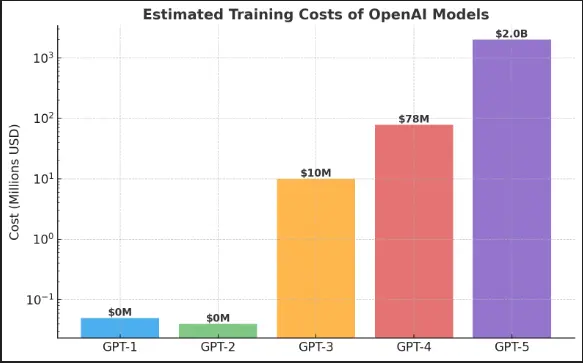On August 7, 2025, a new era in artificial intelligence officially began. After months of anticipation, OpenAI unveiled GPT-5, a model they describe as "significantly better" than all previous iterations and a "significant step toward AGI" (Artificial General Intelligence). This wasn't just another incremental upgrade; it was the debut of what is likely the most expensive and powerful AI system in history, with an estimated $2+ billion poured into its development.
The numbers are staggering, but they only tell part of the story. The real breakthrough of GPT-5 is not just its cost, but its revolutionary capabilities. It's an AI that delivers PhD-level performance, masters multiple modalities, and comes in a family of tiered models designed to be both more accessible and more useful than anything that has come before. This blog post will break down the incredible investment behind GPT-5, the new features that justify its price tag, and what it all means for the future of AI.
The Astronomical Cost of Intelligence
Training a world-class large language model has always been a resource-intensive task, but GPT-5's development sets a new benchmark. It's an investment on a scale that few companies can even contemplate.
Estimated Costs:
- Compute Infrastructure: Rumors suggest a single training run for GPT-5 could have cost over $500 million in compute alone. This isn't just about buying a few GPUs; it’s about building and operating massive data centers filled with the latest, most powerful hardware from companies like NVIDIA.
- Data Acquisition & Curation: The model was trained on an unprecedented amount of data, requiring millions in licensing, and a massive effort to clean, filter, and synthesize.
- Research & Engineering: Years of work by hundreds of the brightest minds in AI, working on everything from model architecture and alignment to safety and ethics.
- Total Estimated Spend: The total cost is a mind-bending $1.25–$2.5 billion. To put that in perspective, this is more than the budget for a major Hollywood blockbuster and roughly 40 times the cost of training GPT-3.

The Features That Justify the Price
GPT-5 isn't just a slightly better version of GPT-4o. It's a fundamental leap forward, combining previously separate models and capabilities into one unified, intelligent system. The goal was to create an AI that is not only smarter, but also more useful in the real world.
Key New Features:
- PhD-Level Reasoning: The new model has shown a significant improvement in complex reasoning tasks, from advanced legal and scientific analysis to multi-step logic puzzles. It can now act as a powerful co-pilot for experts in their respective fields.
- Unified Multimodal System: Unlike previous models where you had to switch between different modes for text, image, or audio, GPT-5 handles all of these seamlessly. You can have a single conversation that involves discussing a video, editing a document, and generating an image—all in one thread.
- A "Thinking Mode" for Deeper Answers: For complex queries, you can now instruct GPT-5 to "think harder" or "reason more precisely." The model will take a moment to process the request more deeply, often producing more accurate, less-hallucinated responses.
- Unprecedented Context Window: The model’s ability to remember and process a massive amount of information in a single conversation has been dramatically improved. This is a game-changer for anyone dealing with long documents, complex codebases, or extended research projects.
- Agentic Capabilities: GPT-5 is designed to be a better "agent," meaning it can not only answer questions but also take action. It can generate and debug code, plan workflows, and interact with various tools more autonomously than any previous model.
3. The AI Arms Race: Where GPT-5 Fits In
The launch of GPT-5 doesn't happen in a vacuum. It's the latest move in a high-stakes competition with other tech giants. With Google's Gemini, Anthropic's Claude, and xAI's Grok all vying for the top spot, OpenAI's latest model is its biggest play yet to maintain its leadership.
Model | Max Context Window | Modalities Supported | Strengths | Est. Training Cost |
| GPT-5 (OpenAI) | 256K tokens | Text, Image, Audio, Video | Best-in-class reasoning, deep multimodality, multiple tiers | $1.25–$2.5B |
| Gemini 2.5 (Google) | ~1M tokens | Text, Image, Code, Video | Superior document handling, tight Google integration | ~$500M–$800M |
| Claude Opus 4 (Anthropic) | 200K+ tokens | Text, Code | Exceptional safety & transparency, strong reasoning | ~$300M–$500M |
| Grok 3 (xAI) | ~128K tokens | Text, Web Data | Real-time web awareness, strong math & logic | ~$250M–$400M |
This isn’t just a race to build the biggest or most expensive model. It’s a race to prove that these investments translate into real-world utility. Each company is trying to find its niche, but with GPT-5, OpenAI is attempting to be the most versatile and powerful AI of all.
The Path to AGI and Beyond
OpenAI’s mission has always been to "ensure that artificial general intelligence benefits all of humanity." GPT-5 is a critical step on that path. By making a powerful, unified model accessible to millions, and by deeply integrating it into platforms like Microsoft Copilot and GitHub, OpenAI is bringing AGI-like capabilities to everyday life.
Of course, the launch of such a powerful model also comes with significant risks. The need for improved safety, alignment, and interpretability has never been more critical. OpenAI has made significant strides in this area, but the AI community will be watching closely to see how GPT-5 performs under the scrutiny of real-world use.
The massive investment in GPT-5 is a clear signal: the AI race is accelerating, and the stakes have never been higher. The question now is not just who will win, but how we, as a society, will handle the incredible power that these models are beginning to unlock.